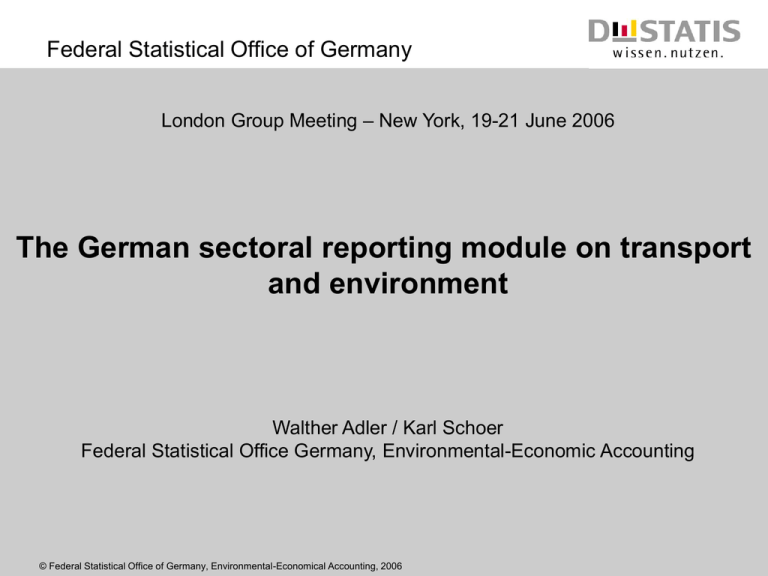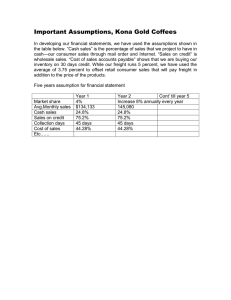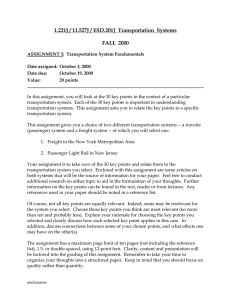The German sectoral reporting module on transport and environment
advertisement

Federal Statistical Office of Germany London Group Meeting – New York, 19-21 June 2006 The German sectoral reporting module on transport and environment Walther Adler / Karl Schoer Federal Statistical Office Germany, Environmental-Economic Accounting © Federal Statistical Office of Germany, Environmental-Economical Accounting, 2006 Federal Statistical Office of Germany Overview 1 Goals 2 Methodology 3 Analysis 2.1 Transport’s share on environmental pressures 2.2 The environmental efficiency of transport 2.3 Decomposition of change of the transport-related environmental pressures 2.4 Decomposition of change of freight transport performance 2.5 Econometric modelling of environmental-economic effects of transport © Federal Statistical Office of Germany, Environmental-Economical Accounting, 2006 Federal Statistical Office of Germany Goals of the Project -Sectoral reporting modules: deepening (disaggregation of existing variables) and enhancing (inclusion of new variables) of the EEA-standard data-set in order to obtain more detailed and integrated accounting data on issues that are especially policy relevant. -Mobility is a important topic of sustainable development policy -There strong interlinkages between transport and other SD topics (need for integrated accounting data) © Federal Statistical Office of Germany, Environmental-Economical Accounting, 2006 Federal Statistical Office of Germany Methodology 1 - Definition: motorised transportation of people and freight over land and water, and in the air. -Integration: transport data a accounting satellite system (same concepts, definitions, classifications) = mainly reformatting of existing data - Accounting concepts for transport: Production perspective (who is the produces of the transport service?): production of transport services by resident units (homogeneous branches in a NAMEA-type breakdown / mode of transport) Use perspective (who is the user of the transport service?): transport of goods for intermediate or final use (in a NAMEA-type breakdown) on the economic territory -Variables: Kilometres driven, passenger and freight transport performance, transport related energy use, transport related air emissions, land use (transport area) © Federal Statistical Office of Germany, Environmental-Economical Accounting, 2006 Federal Statistical Office of Germany Methodology 2 Calculation method (so far only production perspective): Example road transport: Starting point: stock of vehicles in a detailed breakdown by type and technical classes as well as by type of owner. The ownership classification is transformed into the classification of economic activities (production branches, private households) of the national accounts by using various data which are available in the National Accounts on asset stocks and burden distributions of mineral oil tax. Those stock data are the basis for assigning the flow information on kilometres covered, transport performance, energy and emissions to the economic activities. © Federal Statistical Office of Germany, Environmental-Economical Accounting, 2006 Federal Statistical Office of Germany Transport-related environmental burdens 2001 by passenger and freight transport Share of transport in total economy in % Passenger transport Energy consumption Freight transport 18,1 Greenhouse gasses 17,3 19,5 CO2 48,2 NOx 2,5 SOx NMVOC Land use for housing and transport 16,0 39,0 0 20 © Federal Statistical Office of Germany, Environmental-Economical Accounting, 2006 40 60 % Federal Statistical Office of Germany Environmental intensity of freight transport by modes of transport, including electricity generation for rail 1) Environmental burdens per freight traffic output Road2) Rail Inland waterways 2001 Gigajoule / mill. tkm 1 961 450 197 Energy Change 2001 as against 1995 in % -6,0 -18,7 -46,4 t CO2-equivalents / mill. tkm 141 27 14 Greenhouse gasses -7,4 -12,8 -47,7 t / mill. tkm -7,3 -12,7 139 CO2 26 14 -47,6 kg / mill. tkm 888 NOx 114 199 -32,4 -22,3 -46,9 kg / mill. tkm 21 SO2 17 2 -82,7 -67,2 -87,3 kg / mill. tkm -65,6 155 13 -23,2 NMVOC 34 -46,6 1) Conversion losses and emissions in electricity generation for traction of rail engines 2) not incl. light commercial vehicles up to 3.5 tonnes permissible total weight and not incl. special vehicles. © Federal Statistical Office of Germany, Environmental-Economical Accounting, 2006 Federal Statistical Office of Germany Energy intensity of land freight transport by homogeneous branches Environmental burdens per freight traffic output Changes 2001 as against 1995 in % 2001 Gigajoules / mill. tkm 2 024 Products of agriculture, forestry and fishing 2 436 0,2 Mining -5,2 Manufacturing 2 282 2 436 2 446 Electricity, gas and water supply -2,1 -17,9 4,1 Construction 2 040 Trade -6,5 1 971 Other services (not incl. transport) -3,6 Transport, storage and communication -4,9 All homogeneous branches -5,5 1 174 1 437 © Federal Statistical Office of Germany, Environmental-Economical Accounting, 2006 Federal Statistical Office of Germany Energy consumption of freight transport1) Change 2001 as against 1995 by effects of various influencing factors Effect of energy intensity of freight transport Effect of sector structure of freight transport Effect of transport volume of freight transport - 11,3 Energy consumption in PJ - 45,0 87,8 -30 0 30 60 90 1) Modes of transport road, rail and inland shipping, not incl. light commercial vehicles up to 3.5 tonnes permissible total weight and not incl. special vehicles. © Federal Statistical Office of Germany, Environmental-Economical Accounting, 2006 Federal Statistical Office of Germany Decomposition analysis of freight transport performance The freight transport performance itself can be depicted as a mathematical product of five factors: FTP GDP VAM TSM TONS FTP GDP VAM TSM TONS Scale effect: Change of GDP at constant prices. Degree of tertiarisation (service sector share): gross value added of material production to total production (VAM / GDP). Factual division of labour in the material production: relationship between total supply of material goods in monetary units to the gross value added of material goods production (TSM/VAM). Degree of refining of the transported goods: total weight of the transported goods is related to the total supply of material goods in monetary terms (TONS/TSM). Spatial differentiation of economic activities: freight transport performance to total freight volume in tonnes (FTP/TONS). © Federal Statistical Office of Germany, Environmental-Economical Accounting, 2006 Federal Statistical Office of Germany Freight transport performance of land transport Change 2001 as against 1995 by effects of various influencing factors Degree of refining Tertiarisation Scale Factual division of labour Spatial differentiation of economic activities Freight transport performance in mill. tkm 44 959 - 138 185 -300 000 - 43 302 - 150 000 © Federal Statistical Office of Germany, Environmental-Economical Accounting, 2006 101 905 114 424 0 150 000 300 000 Federal Statistical Office of Germany German sustainability indicators: business-as-usual forecast Indicator Intensity of passenger transport Intensity of goods transport Share of rail transport to total goods transport performance Energy productivity Green house gas emissions Air pollution Increase of the settlement and traffic area Unit 1991 2000 2010 2020 1999=100 1999=100 102.9 90.6 94.7 99.8 84.9 102.8 77.1 106.4 in % 1990=100 1990=100 1990=100 hectare per day Euro in % 20.0 104.6 95.6 85.7 15.1 122.5 81.2 50.2 13.3 137.7 78.8 44.5 11.6 170.5 78.1 38.9 119.7 21312 65.8 129.2 23943 65.5 93.4 27034 67.2 81.5 32010 73.2 3.0 23.8 -1.3 21.7 3.3 17.3 2.7 15.6 Gross domestic product per capita Employment ratio Increase of budget deficit in % of GDP in % of GDP Capital formation ratio Source: Gesellschaft für wirtschaftliche Strukturforschung © Federal Statistical Office of Germany, Environmental-Economical Accounting, 2006 Federal Statistical Office of Germany Simulation of the effect of doubling the road toll for heavy goods vehicles 2010 Intensity of goods transport (1999=100) Share of rail transport to total goods transport performance (%) CO2-emissions (million tons) GDP per capita (Euro 1995) Employment (1000) Source: Gesellschaft für wirtschahftliche Strukturforschung © Federal Statistical Office of Germany, Environmental-Economical Accounting, 2006 2020 -3.3 -3.6 1.6 -2.7 16.0 10.0 1.8 -2.9 34.0 28.0 Federal Statistical Office of Germany Thank you! © Federal Statistical Office of Germany, Environmental-Economical Accounting, 2006




